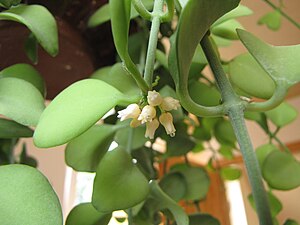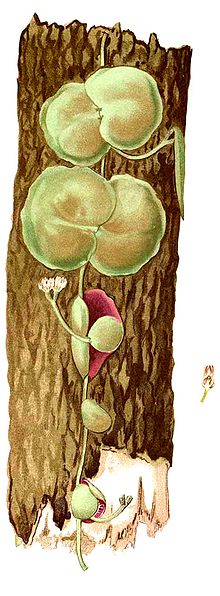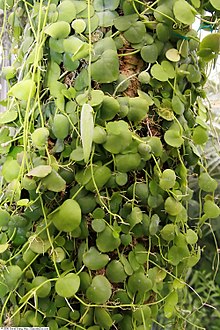Dischidia
| Dischidia | ||||||||||||
|---|---|---|---|---|---|---|---|---|---|---|---|---|

|
||||||||||||
| Systematics | ||||||||||||
|
||||||||||||
| Scientific name | ||||||||||||
| Dischidia | ||||||||||||
| R.Br. |
Dischidia , also called urn plants, is a genus of plants in the subfamily of the silk plants (Asclepiadoideae), which belongs to the family of the dog poison plants (Apocynaceae). About 80 species of the genus Dischidia are currentlyknown.
description
Vegetative characteristics

The species of the genus Dischidia are mostly herbaceous or succulent epiphytes with trailing stem axes , more rarely also epilithic growing, in this case creeping on stones. They usually have pronounced adventitious roots . Otherwise, the roots sit on the nodes ( nodes ). The shoot axes measure 1 to 4 mm in diameter and are glabrous, coarse hairy or tomentose. The milky sap (latex) is white.
The opposite or alternate leaves have only short stems. The leaf blade varies within the genus. There are elongated-elliptical, oval to inverse-lanceolate leaf blades that are flat, lenticular and entire, or round and shield-shaped leaves. The leaf blades are thin and not succulent, or leathery or thickly succulent. A specialty are the species with jug-shaped or tubular leaves (so-called " urn leaves "), which fill up with humus over time and grow into one or two adventitious roots.
Generative characteristics
The many-flowered inflorescence is often racemose , screw-like or divided into partial inflorescences . The flowers usually open asynchronously; only a few open synchronously. Often one inflorescence axis is more or less clearly developed, more rarely several. The flower stalks are short or almost absent. The corolla is relatively narrow and urn-shaped, often very small (a few millimeters), but sometimes also bell-shaped and relatively large. Usually it is white, greenish-white, yellowish-white, cream-colored, slightly reddish, dark red to bluish-green. The flowers of many species of Dischidia also appear closed during anthesis , while in other species the flowers are wide open. The secondary crown is ring-shaped or five-lobed, with the secondary crown lobes alternating with the crown lobes. The corolla lobes are usually two-lobed apically and curved inward. The secondary crown can also be completely absent. The mostly conical gynostegium is seated or pedicled. The stylus head is conical and is enveloped by the anthers . The oblong-oval pollinia stand upright; the caudiculae are usually broadly triangular. The slender, spindle-shaped and bare fruits are round or somewhat flattened and pointed at the end. They stand alone or in pairs. The flattened, brown seeds are oblong to oval and have a tuft of white hair.
The number of chromosomes is (in Dischidia bengalensis Colebr. , Dischidia hirsuta L. and Dischidia nummularia Blume ).
Way of life
The species of the genus Dischidia grow as epiphytes on trees and stones. However, they have very different requirements for light, temperature and humidity. This also reflects their large geographical distribution area and their distribution in the vertical.
Many species of the genus Dischidia live in symbiosis with ants. The ants live in the tubular or pocket-shaped leaves or under the shield-shaped leaves. They carry material into the tubular leaves, into which one or two adventitious roots then grow, which branch out there. The formation of the tubular or urn-shaped leaves in some species also depends on the nutritional status or location of the plant. Well-fertilized plants or plants in a very favorable location may not develop these leaves at all. In other species with leaves that rest on stones like shields or limpets, ants collect material underneath. Here, too, the adventitious roots grow into it. The shield-like leaves have another function: the moisture stays under these leaves for a very long time. They help the plant to survive dry periods. But other species without pocket-like or shield-like leaves also live myrmekophil . The ants collect the seeds and carry them into their tree nests. There the seeds germinate and the seedlings grow from these nests.
The flowers of many Dischidia species also appear closed during the flowering period; only in a few species is the flower fully open. Little is known about the pollination of the flowers. The pollen is not distributed loosely on the stamens, as is the case with many other plants, but rather concentrated in relatively compact pollinia that are transported as a whole from one plant to another. The pollinia are relatively tight and are torn loose by insect legs. The flowers work on the principle of a clamp trap: the insects get caught with their legs in the secondary crown. When trying to break free, the pollinia tear off and stick to the legs. Rintz (1980) suspects that day and night butterflies pollinate the flowers. Jones (2008) observed night and day butterflies, ants, wasps, bees and flies as they sucked up the nectar that the flowers secrete. However, he emphasizes that this does not mean that they are also the pollinators of the flowers.
Occurrence
The Dischidia species occur in Southeast Asia (southern China, the Philippines, Sri Lanka, Thailand, Vietnam, Laos, Indonesia, Malaysia and India), Australia, Oceania and New Guinea. They grow in tropical to subtropical rainforests at altitudes between sea level and about 2000 meters.
Systematics
The genus Dischidia was established in 1810 by the British botanist Robert Brown . The type species is Dischidia nummularia R.Br. In the course of research history, some synonyms for Dischidia R.Br. accumulated: Collyris M.Vahl , Conchophyllum Blume , Dischidiopsis Schltr. , Dolichostegia Schltr. , Hoyella Ridl. , Leptostemma flower , Oistonema Schltr. , Spathidolepis Schltr.
Jones distinguishes between three sections:
- Section Ascidiophora K. Schum. : With the urn- or pocket-shaped leaves (as well as "normal" leaves), myrmekophil (these include the species Dischidia major , Dischidia vidalii and Dischidia complex )
- Section Conchophyllum : With leaves shaped like a shell or clamshell, myrmekophil (this includes the species Dischidia diphylla , Dischidia cleisthantha , Dischidia imbricata , Dischidia collyris and many other species)
- Section Dischidia : Exclusively with "normal" leaves, partly also myrmekophil (other species, for example Dischidia nummularia ); here possibly also the species of the genus Dischidiopsis Schltr.
species
Many species are poorly known and their status is uncertain. Here is a selection of the 119 species of Dischidia :
- Dischidia aberrans Schltr. : Sumatra.
- Dischidia acuminata Costantin : Cambodia, Thailand, Vietnam.
-
Dischidia acutifolia Maingay fil. : With two subspecies:
- Dischidia acutifolia subsp. acutifolia : Indochina to Malesia.
- Dischidia acutifolia subsp. klossii (Ridley) Rintz : Thailand and Malaysia.
- Dischidia albida handle. : Malesia.
- Dischidia albiflora handle. (= Dischidia collyris Wall. ): Indochina to western Malesia.
- Dischidia alternans Schltr. : Sumatra.
- Dischidia amphorantha K. Schum. & Lauterb. : New Guinea.
- Dischidia angustifolia Miq. : Eastern Java.
- Dischidia antennifera Becc. : Borneo.
- Dischidia apoensis Elmer : Mindanao.
- Dischidia asperifolia Schltr. : Borneo.
- Dischidia astephana Scortechini ex King & Gamble : Malaysia and Borneo.
- Dischidia atropurpurea Schltr. : Sumatra.
- Dischidia australis Tsiang & PTLi : China.
- Dischidia bengalensis Colebrooke : Himalaya to western Malesia.
- Dischidia bisetulosa O.Schwartz : Borneo.
- Dischidia boholensis (Schltr.) Livsh. : Philippines ( Bohol ).
- Dischidia bulacanensis Kloppenb., G. Mend. & Ferreras : Philippines.
- Dischidia calva Pearson : Thailand.
- Dischidia chinensis Champ. ex Benth. : China and Vietnam.
- Dischidia cleistantha Livsh. : Philippines.
- Dischidia clemensiae Schltr. : Mindanao .
- Dischidia cochleata flower : Western Malesia.
- Dischidia cominsii Hook. : Solomon Islands .
- Dischidia complex handle. : Malaysia and Borneo.
- Dischidia cornuta Livsh. : Laos .
- Dischidia crassifolia Zipp. ex Schltr. : Lesser Sunda Islands .
- Dischidia crassula Schltr. : Sulawesi.
- Dischidia cyclophylla Schltr. : New Guinea.
- Dischidia cylindrica W.W.Sm. : Borneo.
- Dischidia dasyphylla Schltr. : Sulawesi.
- Dischidia deschampsii King & Gamble : Malay Peninsula.
- Dischidia digitiformis Becc. : Sulawesi.
- Dischidia diphylla Elmer : Luzon.
- Dischidia dohtii Tran & Livsh. : Laos and Vietnam.
- Dischidia dolichantha Schlechter : Western Malesia.
- Dischidia elmeri Schltr. : Mindanao.
- Dischidia ericiflora Becc. : Borneo.
- Dischidia formosana Maximowicz : Nansei Islands to Taiwan.
- Dischidia fruticulosa Ridley : Malay Peninsula.
- Dischidia galactantha K. Schum. : New Guinea.
- Dischidia gibbifera Schltr. : Luzon.
- Dischidia griffithii handle. ex Hook. f. : Thailand, Myanmar and Vietnam.
- Dischidia hahliana Volkens : Carolinen .
- Dischidia hirsuta (flower) Decaisne : Indochina to Papua Asia.
- Dischidia hollrungii Warb. ex K.Schum. & Lauterb. : New Guinea.
- Dischidia hoyella Omlor : Sumatra.
- Dischidia imbricata (flower) Steudel : Indochina to western Malesia.
- Dischidia immortalis Guillaumin : Vanuatu.
- Dischidia indragirensis Schltr. : Sumatra.
- Dischidia insularis Schltr. : New Guinea.
- Dischidia kerrii Kidyoo & Suddee : Thailand and Vietnam.
- Dischidia khasiana Hook.f. : Assam.
- Dischidia lanceolata (flower) Decaisne : Western Java.
- Dischidia lancifolia Ridley : Philippines.
- Dischidia latifolia (flower) Decaisne : Java.
- Dischidia lauterbachii K.Schum. : New Guinea.
- Dischidia listerophora Schltr. : Bismarck Archipelago.
- Dischidia litoralis Schltr. : Papua Asia to northern Queensland.
- Dischidia livida Elmer : Luzon .
- Dischidia longe-pedunculata Ridl. : Malay Peninsula.
- Dischidia longiflora Becc. : Moluccas.
- Dischidia longifolia Becc. : Kelien Sunda Islands and New Guinea.
- Dischidia major (Vahl) Merrill : Tropical Asia to northern Queensland.
- Dischidia maxima coord .: Sulawesi.
- Dischidia melanesica Fosberg : Santa Cruz Islands .
- Dischidia meleagridiflora O.Schwartz : Borneo.
- Dischidia merrillii Becc. : Philippines.
- Dischidia micholitzii N.E.Br. : Eastern Assam to northern Myanmar.
- Dischidia micrantha Becc. : Western Malesia.
- Dischidia milnei Hemsl. : Bismarck Archipelago to the Solomon Islands.
- Dischidia neurophylla Lauterb. & K.Schum. : Bismarck Archipelago .
- Dischidia nicobarica Didr. : Nicobar Islands .
- Dischidia nummularia R. Br. (Syn .: Dischidia rhombifolia flower ): Tropical Asia to southern China and northern Queensland.
- Dischidia obovata Decne : Java.
- Dischidia oiantha Schltr. : Philippines.
- Dischidia ovata Bentham : New Guinea to northern Queensland.
- Dischidia oxyphylla Miq. : Sulawesi.
- Dischidia parvifolia Ridl. : Malay Peninsula.
- Dischidia peltata flower : New Guinea.
- Dischidia picta flower : New Guinea.
- Dischidia platyphylla Worse : Philippines.
- Dischidia polilloensis Kloppenb. : Philippines.
- Dischidia polyphylla Ridl. : Sumatra and Borneo.
- Dischidia pseudobenghalensis Costantin : Northern Vietnam.
- Dischidia puberula Decne. : Mariana Islands .
- Dischidia pubescens Ridl. : Malay Peninsula. +
- Dischidia punctata (flower) Decaisne : Thailand to Malesia.
- Dischidia purpurea Merrill : Philippines.
- Dischidia quinquangularis Schltr. : Mindanao .
- Dischidia reniformis Schltr. : Malesia.
- Dischidia retusa Becc. : Moluccas.
- Dischidia rhodantha Ridl. : Malay Peninsula.
- Dischidia rimicola Kerr : Thailand, Laos and Vietnam.
- Dischidia rosea Schltr. : Luzon.
- Dischidia roseoflavida Schltr. : Borneo.
- Dischidia rumphii Miq. : Moluccas.
- Dischidia ruscifolia Decaisne ex Beccari : Philippines.
- Dischidia saccata Warb. : Mindanao.
- Dischidia sagittata (flower) Decaisne : Western Java.
- Dischidia sarasinorum Warb. : Sulawesi.
- Dischidia scortechinii King & Gamble : Malay Peninsula.
- Dischidia singaporensis Ridl. : Malay Peninsula.
- Dischidia singularis Craib : Thailand.
- Dischidia soronensis Becc. : New Guinea.
- Dischidia sorsoganensis Elmer : Luzon.
- Dischidia spironema Turcz. : Java.
- Dischidia squamulosa Becc. : Borneo.
- Dischidia striata Schltr. : New Guinea.
-
Dischidia subulata Warb. with the subspecies:
- Dischidia subulata subsp. angustata Rintz : Malay Peninsula.
- Dischidia subulata subsp. subulata : Malay Peninsula to Sumatra.
- Dischidia superba Rintz : Malay Peninsula.
- Dischidia tjidadapensis Bakh.f. : Western Java.
- Dischidia tomentella Ridl. : Thailand and Malaysia.
- Dischidia tonkinensis Costantin (Syn .: Dischidia balansae Costantin ): China, Thailand, Laos and Vietnam.
- Dischidia tonsa Schltr. : Philippines.
- Dischidia tonsuensis T. Green & Kloppenb. : Sulawesi.
- Dischidia torricellensis (Schltr.) PIForst. : New Guinea.
- Dischidia tricholoba Kerr : Thailand and Vietnam.
- Dischidia trichostemma Schltr. : New Guinea.
- Dischidia truncata (flower) Decaisne : Java.
- Dischidia vadosa Rintz : Malay Peninsula.
- Dischidia vidalii Beccari : Philippines.
- Dischidia wallichii Wight : Darjiling , Andaman and Singapore .
No longer counted in this genus:
- Dischidia chinghungensis Tsiang & PTLi => Hoya chinghungensis (Y.Tsiang & PTLi) MGGilbert, PTLi & WDStevens
swell
literature
- Focke Albers and Ulli Meve (eds.): Succulent lexicon Volume 3 Asclepiadaceae (silk plants) . 322 pp., Ulmer, Stuttgart 2002, ISBN 978-3-8001-3982-8 .
- Victor Rico-Gray and Paulo Santos Oliveira: The ecology and evolution of ant-plant interactions. 331 pp., Chicago, University of Chicago Press, 2007 ISBN 978-0-226-71347-2
- Antone Jones: A look at Dischidia. Stemma, 2 (1), pp. 4–17, 2008 Online (PDF; 4.5 MB)
Online source
Individual evidence
- ↑ a b c d Jones (2008: p. 4ff.)
- ^ RE Rintz: The peninsular Malaysian species of Dischidia (Asclepiadaceae). In: Blumea , 26: 81-126, Leiden 1980 ISSN 0006-5196
- ↑ a b c d e f g h i j k l m n o p q r s t u v w x y z aa ab ac ad ae af ag ah ai aj ak al am an ao ap aq ar as at au av aw ax ay az ba bb bc bd be bf bg bh bi bj bk bl bm bn bo bp bq br bs bt bu bv bw bx by bz ca cb cc cd ce cf cg ch ci cj ck cl cm cn co cp cq cr cs ct cu cv cw cx cy cz da db dc dd de df dg dh di dj dk dl dm dn do dp dq dr ds dt du dv Rafaël Govaerts (Ed.): Dischidia - World Checklist of Selected Plant Families of the Royal Botanic Gardens, Kew. Last accessed on November 13, 2018.







